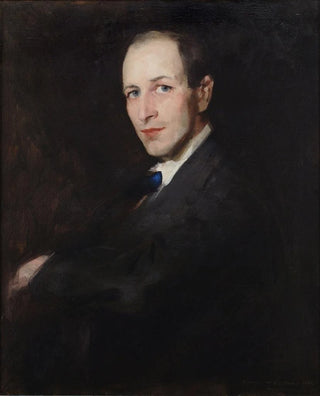Art print | George Wesley Bellows - Robert Henri


View from behind

Frame (optional)
In the fascinating world of early 20th-century American art, the "Robert Henri" art print by George Wesley Bellows stands out for its depth and vibrancy. This piece, both portrait and character study, captures not only the physical appearance of one of the greatest masters of the realist movement but also the very essence of his artistic spirit. Through this artwork, Bellows invites us to delve into a moment of intimacy, where the artist reveals himself in all his complexity, awakening an insatiable curiosity about the stories hidden behind the faces.
Style and uniqueness of the work
Bellows' style is characterized by an exceptional mastery of chiaroscuro and a vibrant palette that gives his subjects an almost sculptural dimension. In "Robert Henri," the use of shadows and lights highlights the facial features of his friend and mentor. The piece stands out with striking realism, where each brushstroke seems to breathe life. Bellows manages to transcend the simple portrait to offer a true psychological study. Henri's eyes, with an intense sparkle, seem to tell stories, while the relaxed posture of the figure evokes both confidence and vulnerability. This duality makes the work an essential piece for understanding the soul of the artist and his era.
The artist and his influence
George Wesley Bellows, an emblematic figure of the Ashcan movement, captured urban life with a unique sensitivity. Influenced by masters such as Édouard Manet and Vincent van Gogh, he developed a style that combines dynamism and emotion. Bellows does not merely reproduce reality; he interprets it with an intensity that is his own. His friendship with Robert Henri, also an influential painter and teacher, nourished his artistic vision. Henri, as leader of the "Eight" group, encouraged a freer and more direct approach to art, opposing the academic conventions of the time. Through "Robert Henri," Bellows pays homage to this influence while asserting his own voice, making this artwork a milestone in the history of American art.
An exceptional wall decoration

Matte finish

View from behind

Frame (optional)
In the fascinating world of early 20th-century American art, the "Robert Henri" art print by George Wesley Bellows stands out for its depth and vibrancy. This piece, both portrait and character study, captures not only the physical appearance of one of the greatest masters of the realist movement but also the very essence of his artistic spirit. Through this artwork, Bellows invites us to delve into a moment of intimacy, where the artist reveals himself in all his complexity, awakening an insatiable curiosity about the stories hidden behind the faces.
Style and uniqueness of the work
Bellows' style is characterized by an exceptional mastery of chiaroscuro and a vibrant palette that gives his subjects an almost sculptural dimension. In "Robert Henri," the use of shadows and lights highlights the facial features of his friend and mentor. The piece stands out with striking realism, where each brushstroke seems to breathe life. Bellows manages to transcend the simple portrait to offer a true psychological study. Henri's eyes, with an intense sparkle, seem to tell stories, while the relaxed posture of the figure evokes both confidence and vulnerability. This duality makes the work an essential piece for understanding the soul of the artist and his era.
The artist and his influence
George Wesley Bellows, an emblematic figure of the Ashcan movement, captured urban life with a unique sensitivity. Influenced by masters such as Édouard Manet and Vincent van Gogh, he developed a style that combines dynamism and emotion. Bellows does not merely reproduce reality; he interprets it with an intensity that is his own. His friendship with Robert Henri, also an influential painter and teacher, nourished his artistic vision. Henri, as leader of the "Eight" group, encouraged a freer and more direct approach to art, opposing the academic conventions of the time. Through "Robert Henri," Bellows pays homage to this influence while asserting his own voice, making this artwork a milestone in the history of American art.
An exceptional wall decoration






